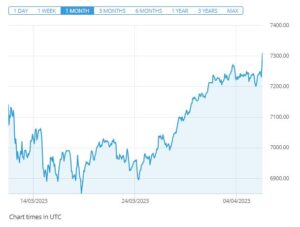In a shorter week of trade due to Easter, the ASX200 rose 0.6% last week with 10 of 11 sectors finishing in the green. Healthcare led the way jumping 3.83% whilst the materials sector was the laggard down 2.72% for the week.
Overseas, the S&P 500 fell 0.1% last week with Tesla (TSLA) a drag on the index down by more than 10%, but healthcare led sector performance.
3 things that happened last week:
1. RBA keeps cash rate on hold
After ten consecutive hikes, the Reserve Bank of Australia paused its current hiking cycle, leaving the cash rate unchanged at 3.6%.The board were quick to point to the recent banking issues overseas, and they clearly believe that the tighter financial conditions we’re starting to see will do some of the RBA’s job for them. The caveat to this pause was the board leaving the door open to further hikes and making sure their language couldn’t be misled as this being ‘the end’. They hinted at further tightening of monetary policy and said they would do what is necessary to return inflation to target. So, yes, inflation has peaked but if it doesn’t follow the path that the RBA wants, it could feel the need to re-tighten, which could be a big shock to the economy and financial markets.
2. Oil surges as OPEC+ cuts output
Following a shock cut in output from OPEC+ last week, Oil surged above $80 a barrel to its highest price since January. The output reduction will see production cuts expected to reach nearly 1.2M barrels per day until the end of 2023 in a bid to support prices. The worry for investors though is the impact this cut to output will have on the economy. Oil prices offer a real threat to inflation, which then makes central banks’ jobs even more difficult. The Fed is trying to control price pressures and higher oil prices doesn’t help. The outlook for oil is still cloudy with a US recession edging closer, but this cut in output should keep prices elevated for now.
3. A winner and loser last week from the S&P/ASX200
Following Gold’s recent run, Evolution Mining (EVN) was one of the top performers on the ASX200 last week climbing by 8.3%. With gold closing in on new record highs, the next few weeks could be important for Evolution investors.
Market darling Pilbara Minerals (PLS) was one of the worst performers last week, falling by 8.4%. The lithium miner fell after lithium giant Albemarle was downgraded by analysts on the back of falling lithium prices.
3 things to watch for the week ahead:
1. Australian Unemployment: Still near 50-year lows
After the RBA decided to keep interest rates on hold this week, the attention now turns to the incoming data to see if they will hike again in May. The first data set is unemployment giving us a view of the tight labour market. Last month, unemployment came through at 3.5 per cent, near decade lows and much lower than the RBA would like. The worry for the RBA is a wage spiral that feeds inflation with the jobs market so tight. Data released by the ABS shows that there were more than 430,000 jobs for Aussies at the end of February, putting employees in the driving seat to negotiate pay rises. One way the RBA hopes to see unemployment rise is with the 650,000 overseas migrants expected to reach Australia over the next two years. On the one hand, this helps to ease some of the pressures in the labour market, but it will also significantly impact the housing market. With Australia already in a housing crisis, further rental price increases could be another price pain for the RBA.
2. US Inflation: Moving in the right direction, but core inflation a worry
The most watched number in markets is released on Wednesday this week, with US inflation expected to decline for the 9th consecutive month. Ultimately, inflation is moving in the right direction, but it may not be falling as fast as the Federal Reserve would like. The market is currently pricing in a pause from the Fed on May 3rd when it meets again, but if this week’s inflation number is strong, then that may turn the dial towards another hike. Another bump in the road came this week with OPEC’s surprise output cut, which saw a surge in oil prices giving the Fed yet another headache in their fight against inflation. A big worry for the Fed is controlling core inflation, given it has only fallen 1% since its peak in March 2021. Markets expect core inflation to accelerate again last week, climbing to 5.6% from 5.5%, whilst headline inflation is expected to fall again thanks to falling energy costs.
3. Gold: Closing in on record highs
With inflation still elevated worldwide, and plenty of economic uncertainty, Gold is closing in on its 2020 high of around $2,060. The precious metal has climbed more than 9% in the last month as recession concerns mount and investors flock to the proven safe haven, with the world’s largest gold ETF (SPDR Gold $GLD) seeing over a billion dollars of inflows within the last month. Gold also has a huge part to play in Central Bank reserves, and 2023 has seen the strongest start to the year from central banks buying gold for more than a decade, following a record high last year. The outlook for gold topping a new high looks positive, with strong central bank and investor demand. The bounce back of gold prices in 2023 also improves the outlook for local miners such as Newcrest Mining (NCM) and Northern Star Resources (NST). Higher gold prices mean profits should rise, likely leading to improved dividends for investors.
*All data accurate as of 11/04/2023. Data Source: Bloomberg and eToro
Disclaimer:
This communication is general information and education purposes only and should not be taken as financial product advice, a personal recommendation, or an offer of, or solicitation to buy or sell, any financial product. It has been prepared without taking your objectives, financial situation or needs into account. Any references to past performance and future indications are not, and should not be taken as, a reliable indicator of future results. eToro makes no representation and assumes no liability as to the accuracy or completeness of the content of this publication.




